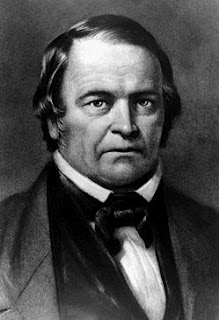By Dr. R. Scott Clark - The Heidelblog:
Introduction
Introduction
 |
| William Miller (February 15, 1782 – December 20, 1849) was an American Baptist preacher who is credited with beginning the mid-19th century North American religious movement known as the Millerites. (Wikipedia) |
Since the early 19th century American Christianity has been largely dominated by a revival of the original Anabaptist theology, piety, and practice. One can transpose much of what took place in the 19th century over the first generation Anabaptists (1520s) and it matches up quite well. The original Anabaptists would have understood completely the Millerite eschatological fervor of the 1820s–40s. They would understand completely the claims of continuing revelation made by Joseph Smith and the Mormons in the same period. At least some of the original Anabaptists would have understood the bald Pelagianism of Charles Finney (1792–1875). The Cane Ridge Revival (1801) would have made perfect sense to the original Anabaptists as it fit their vision of piety almost perfectly.
Evangelical Christianity in America as it has been received in the 20th and 21st centuries is very much the product of that revived Anabaptist theology, piety, and practice. The Second Great Awakening (hereafter, 2GA) was a radically democratic, egalitarian, entrepreneurial, enterprise. Theologically, it was by turns mystical and rationalist. Further, the 2GA did not just happen out of the blue. It did not fall out of the sky like golden plates and magic spectacles. There is a direct, organic connection between the First Great Awakening (hereafter 1GA) and the 2nd but we will press on lest we move from preaching to meddling.
The enthusiastic (in the strict sense) piety of the 2GA faded in the second half of the 19th century but “fresh light” broke forth again in the revivals in Topeka, KS and Azusa Street (Los Angeles) at the turn of the 20th century. The patterns established in the earlier “revivals” have been formative for American evangelicalism.
One aspect of that revivalist pattern is the claim to renewed apostolic phenomena. Suggestions were made in the 18th century and proclaimed loudly in the 19th and 20th centuries that the apostolic phenomena had been restored to those with faith to receive and exercise them. Since the 19th century at least evangelical Christianity (defined broadly) has been divided between the “haves” and “have nots,” i.e., those who claim to have recovered the Apostolic gifts and powers.
 |
| Ellen G. White 1899 - Wikipedia Author and Co-founder of the Seventh-day Adventist Church |
The enthusiastic (in the strict sense) piety of the 2GA faded in the second half of the 19th century but “fresh light” broke forth again in the revivals in Topeka, KS and Azusa Street (Los Angeles) at the turn of the 20th century. The patterns established in the earlier “revivals” have been formative for American evangelicalism.
One aspect of that revivalist pattern is the claim to renewed apostolic phenomena. Suggestions were made in the 18th century and proclaimed loudly in the 19th and 20th centuries that the apostolic phenomena had been restored to those with faith to receive and exercise them. Since the 19th century at least evangelical Christianity (defined broadly) has been divided between the “haves” and “have nots,” i.e., those who claim to have recovered the Apostolic gifts and powers.